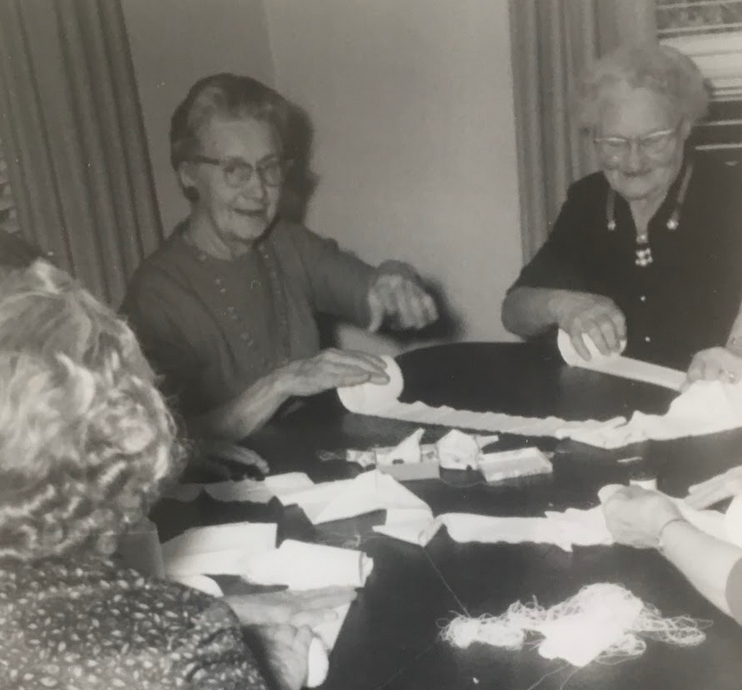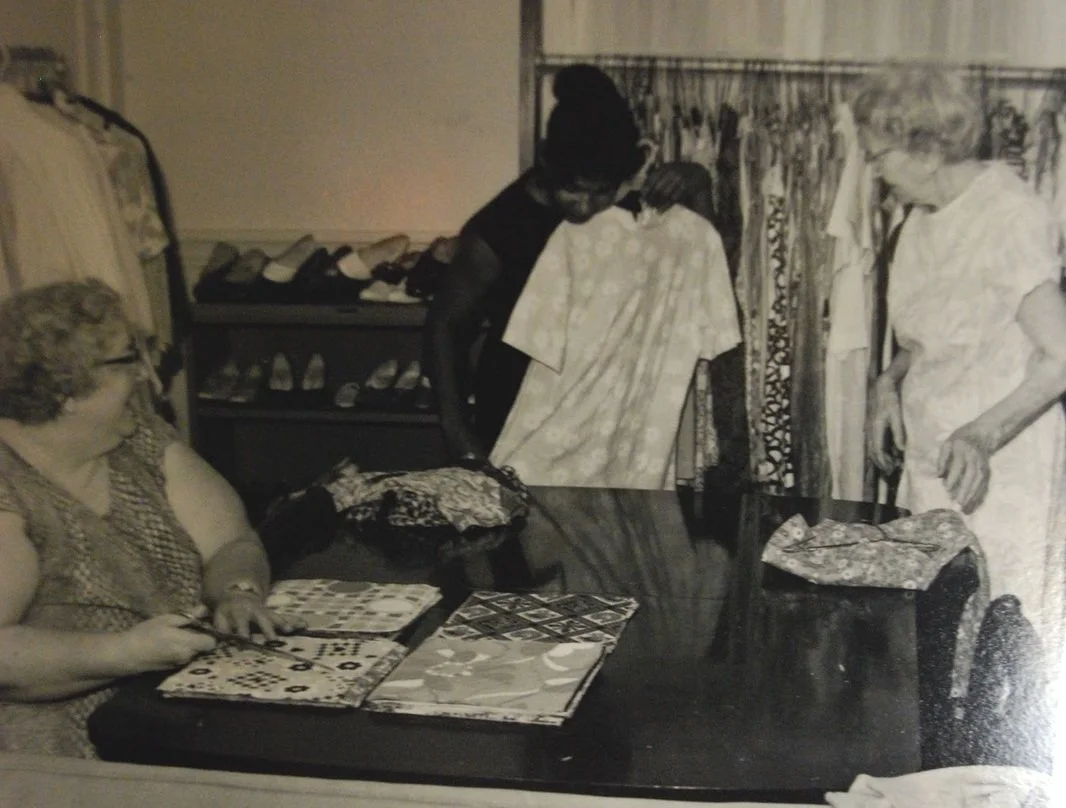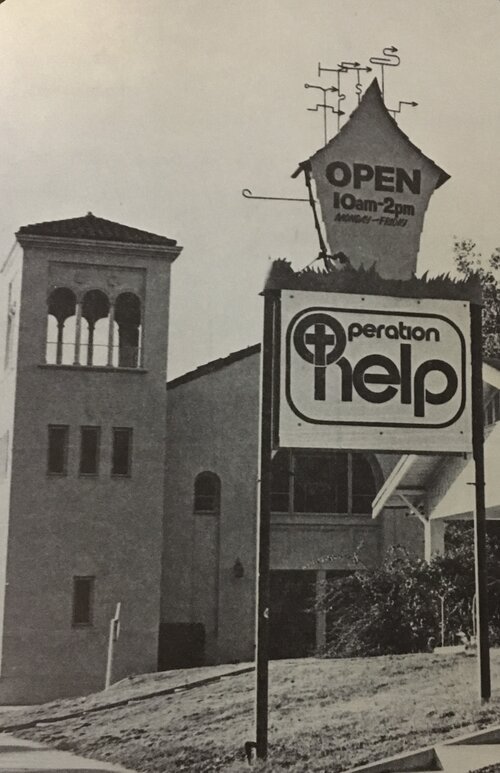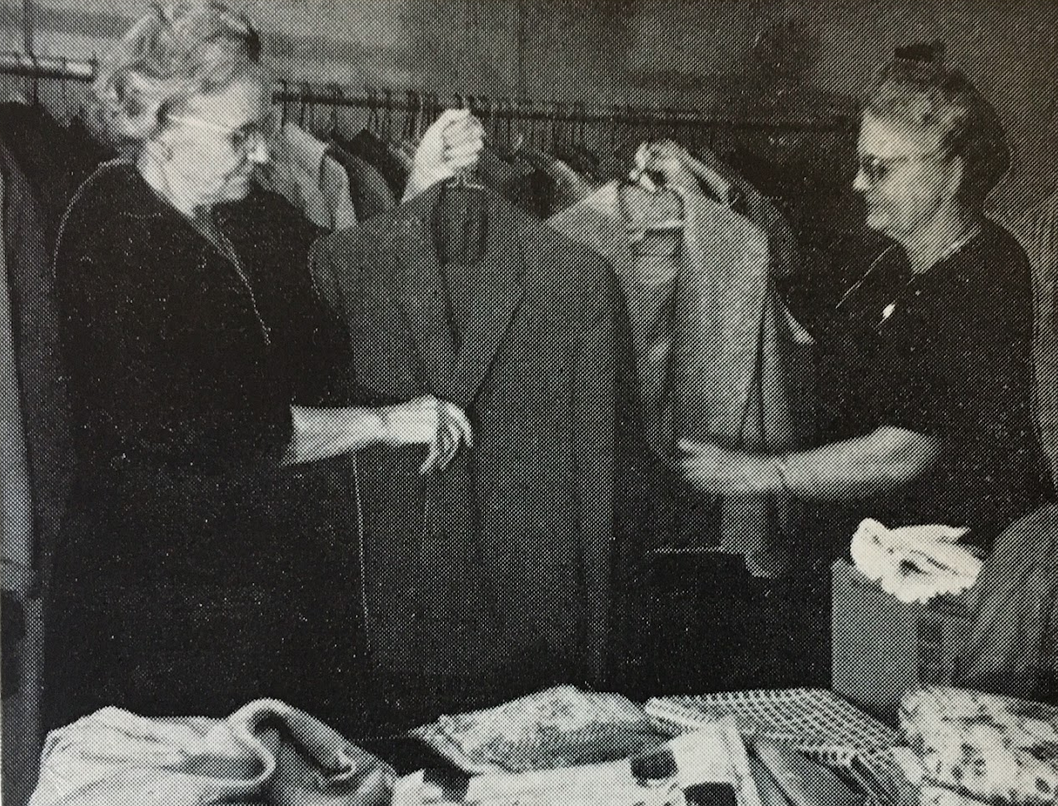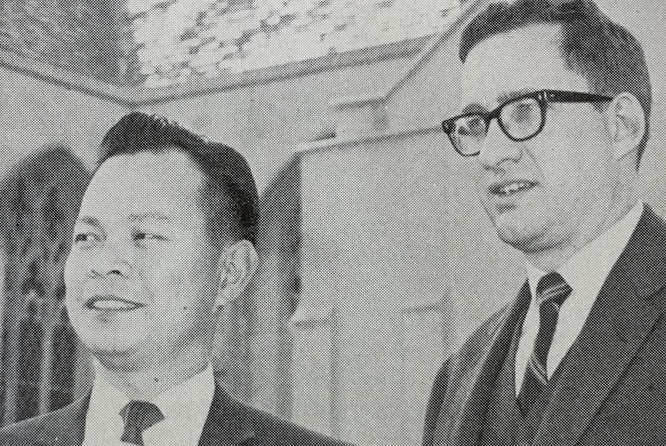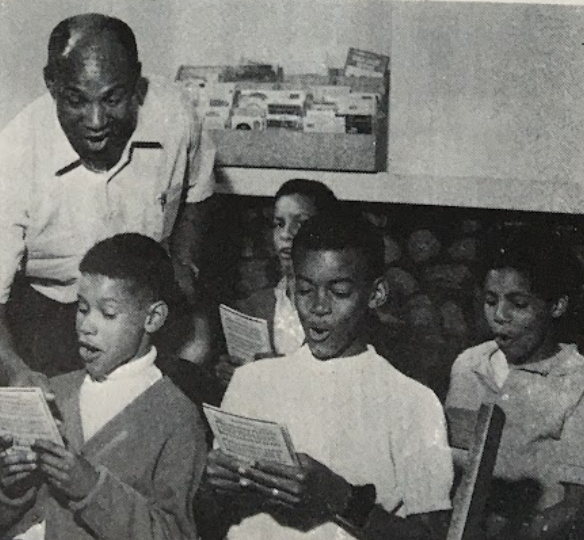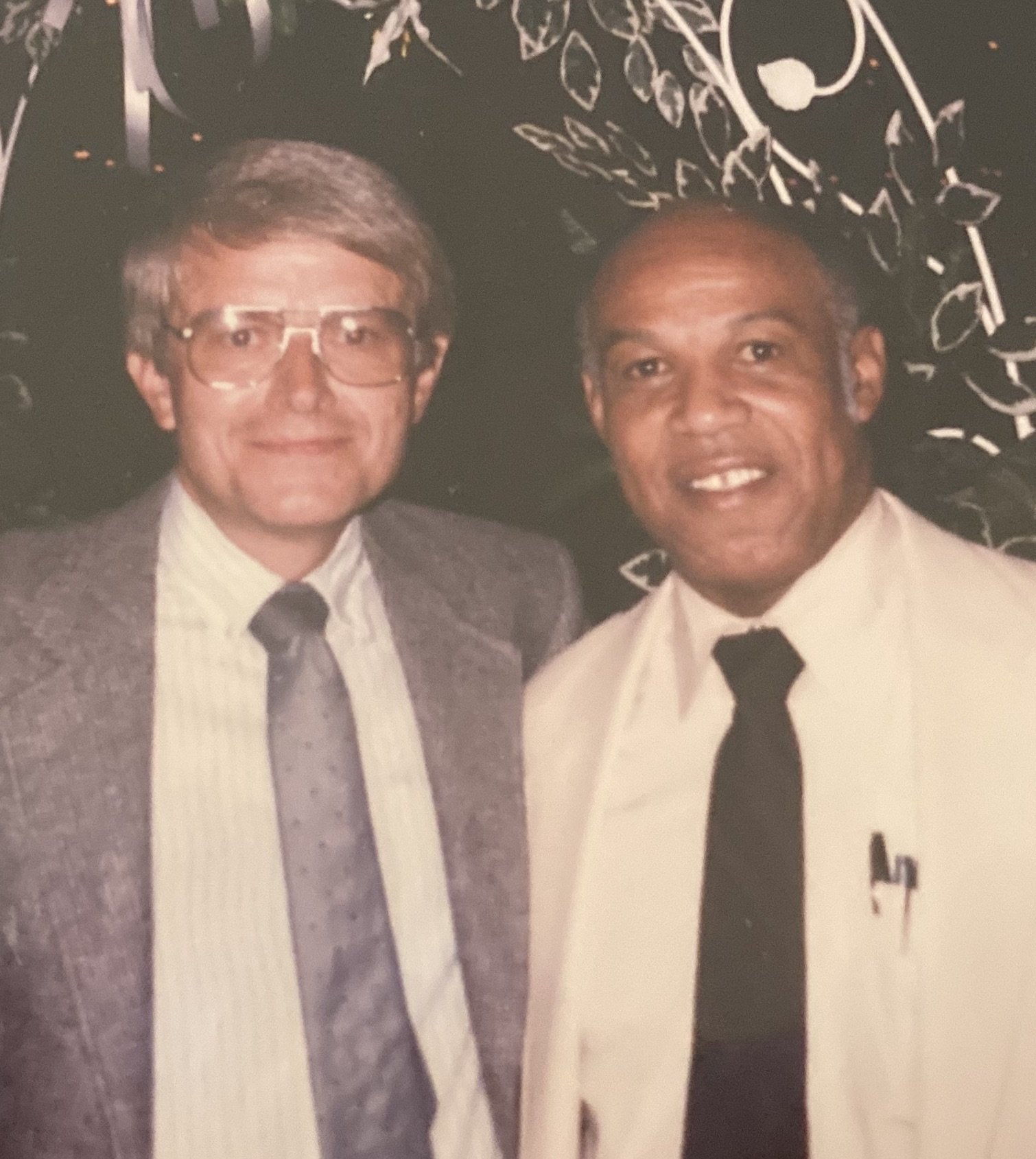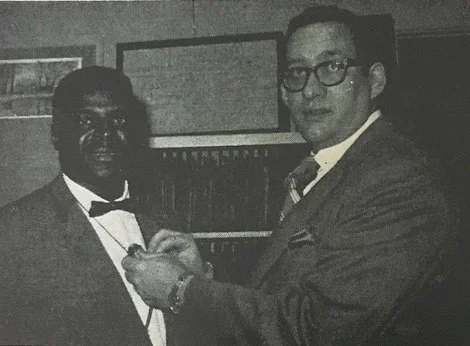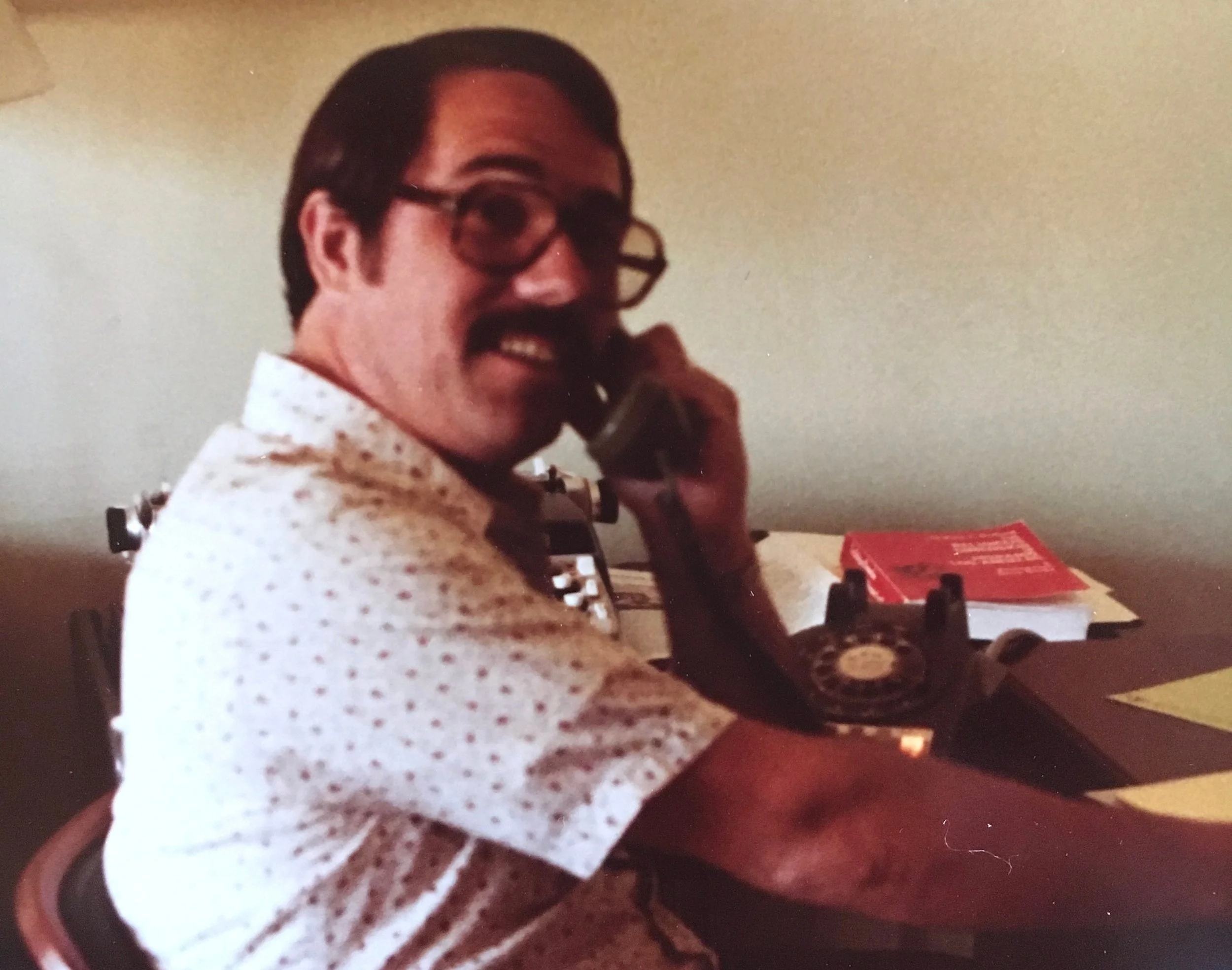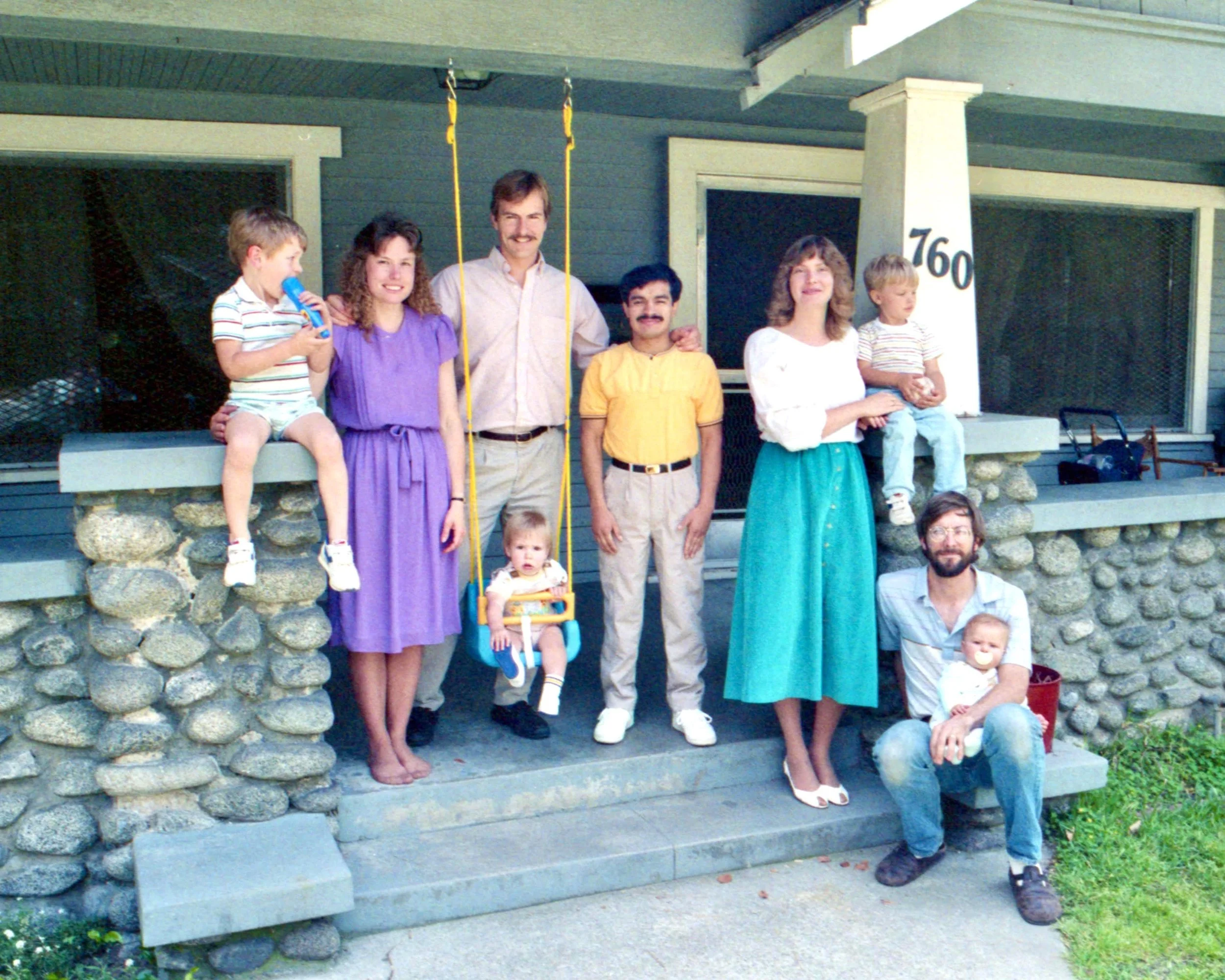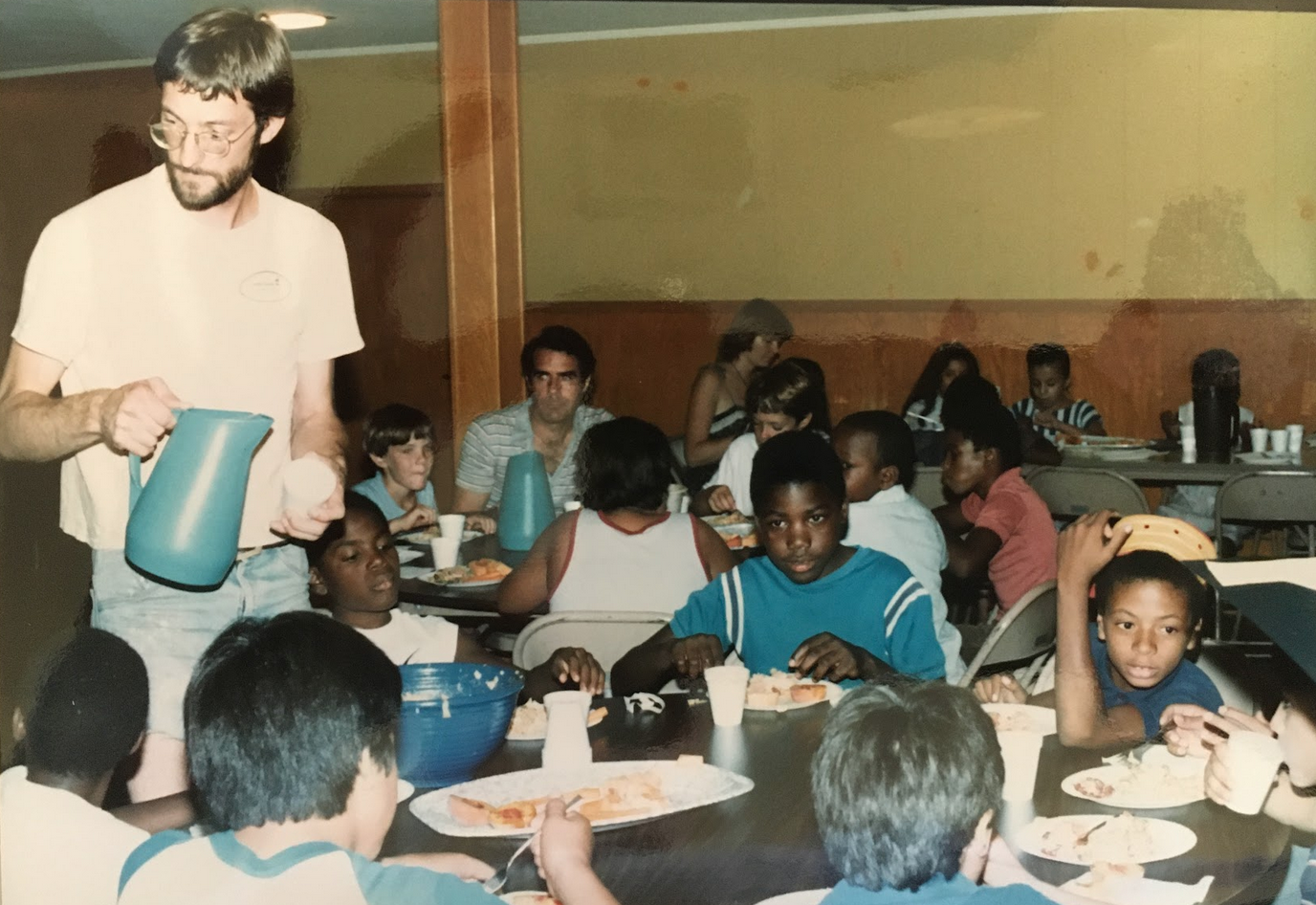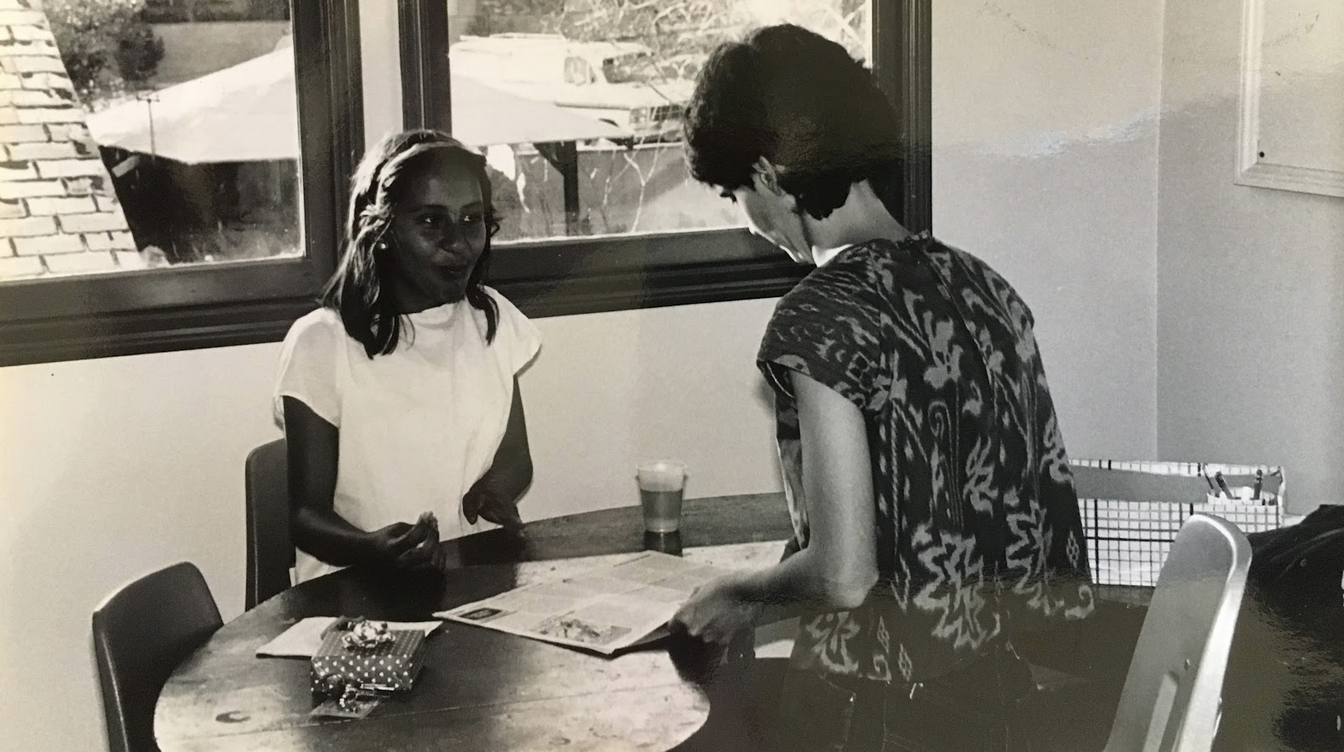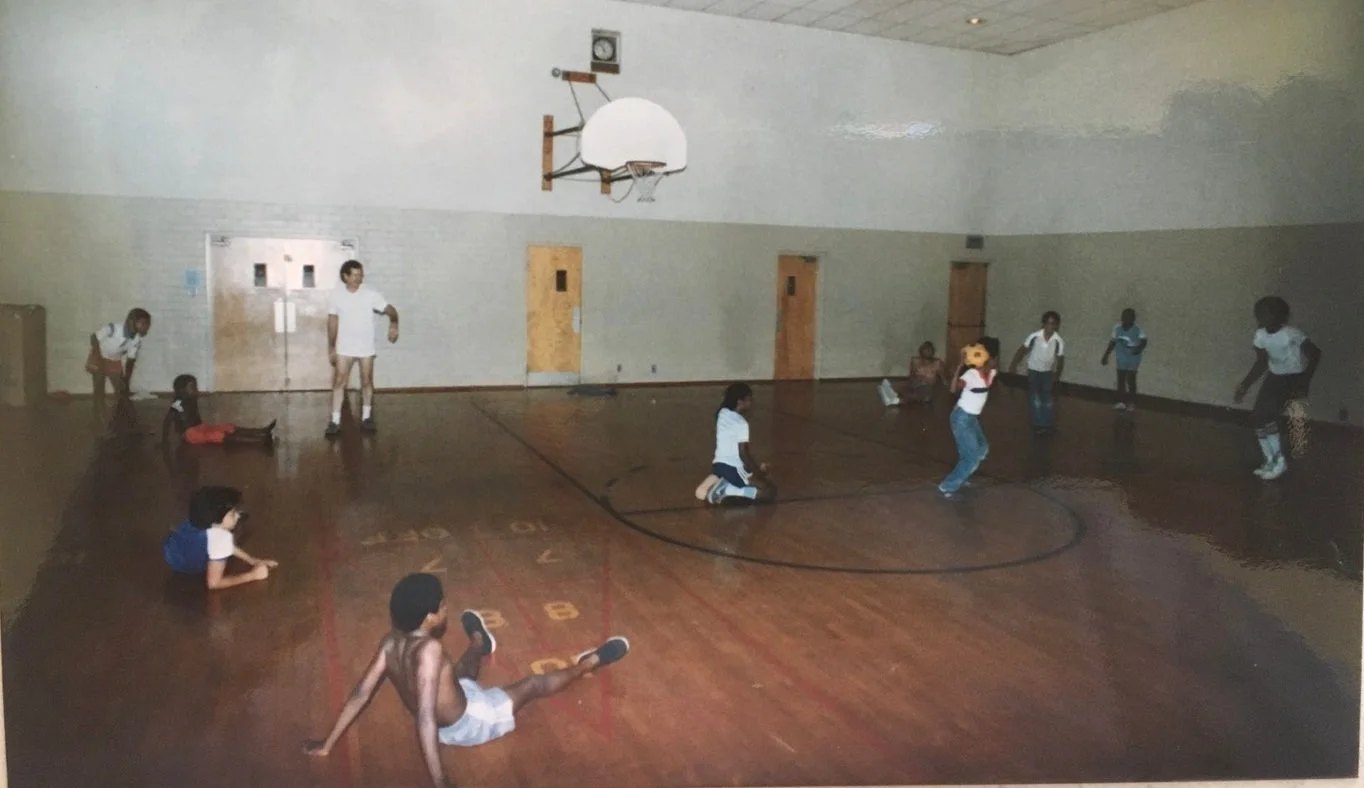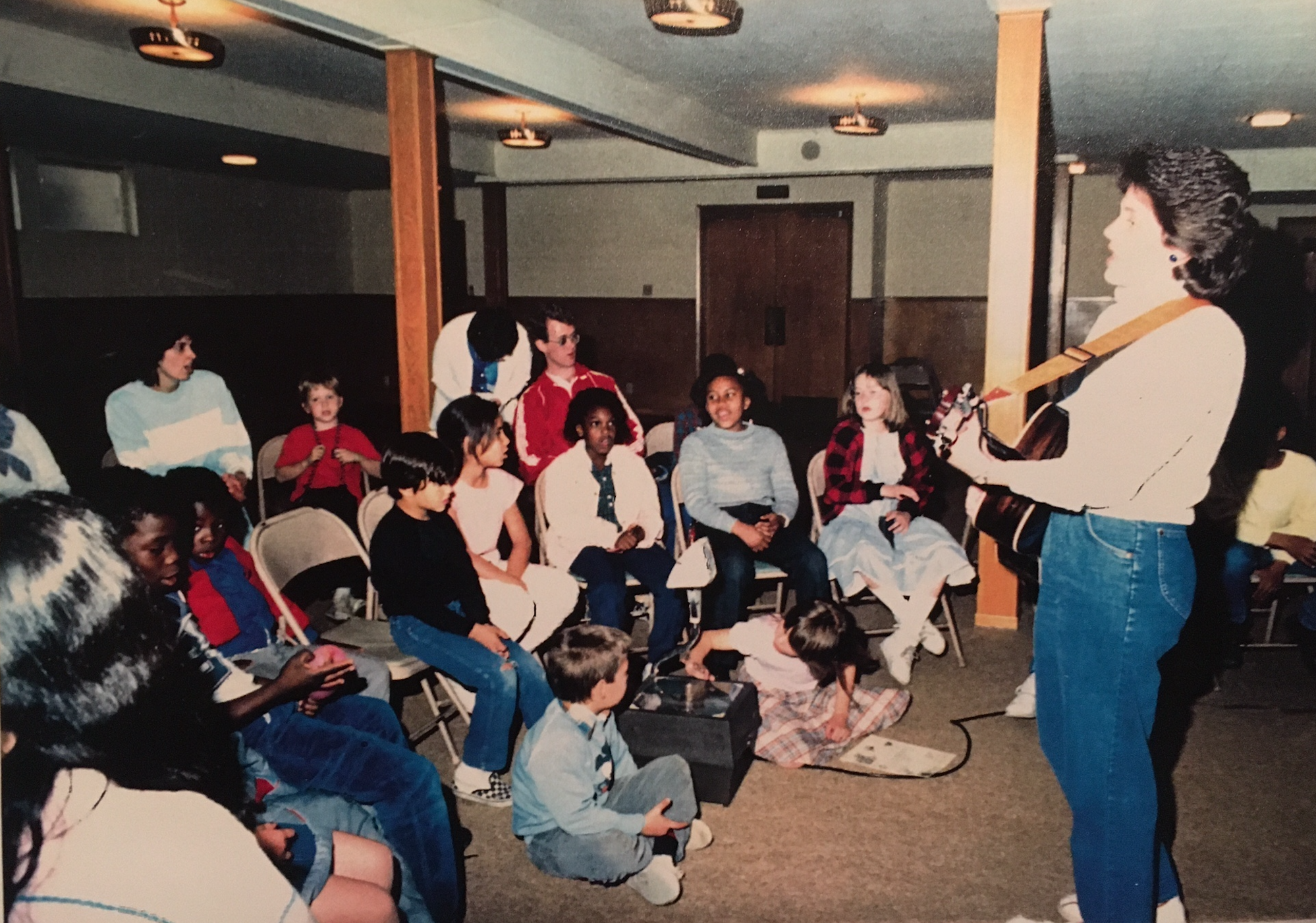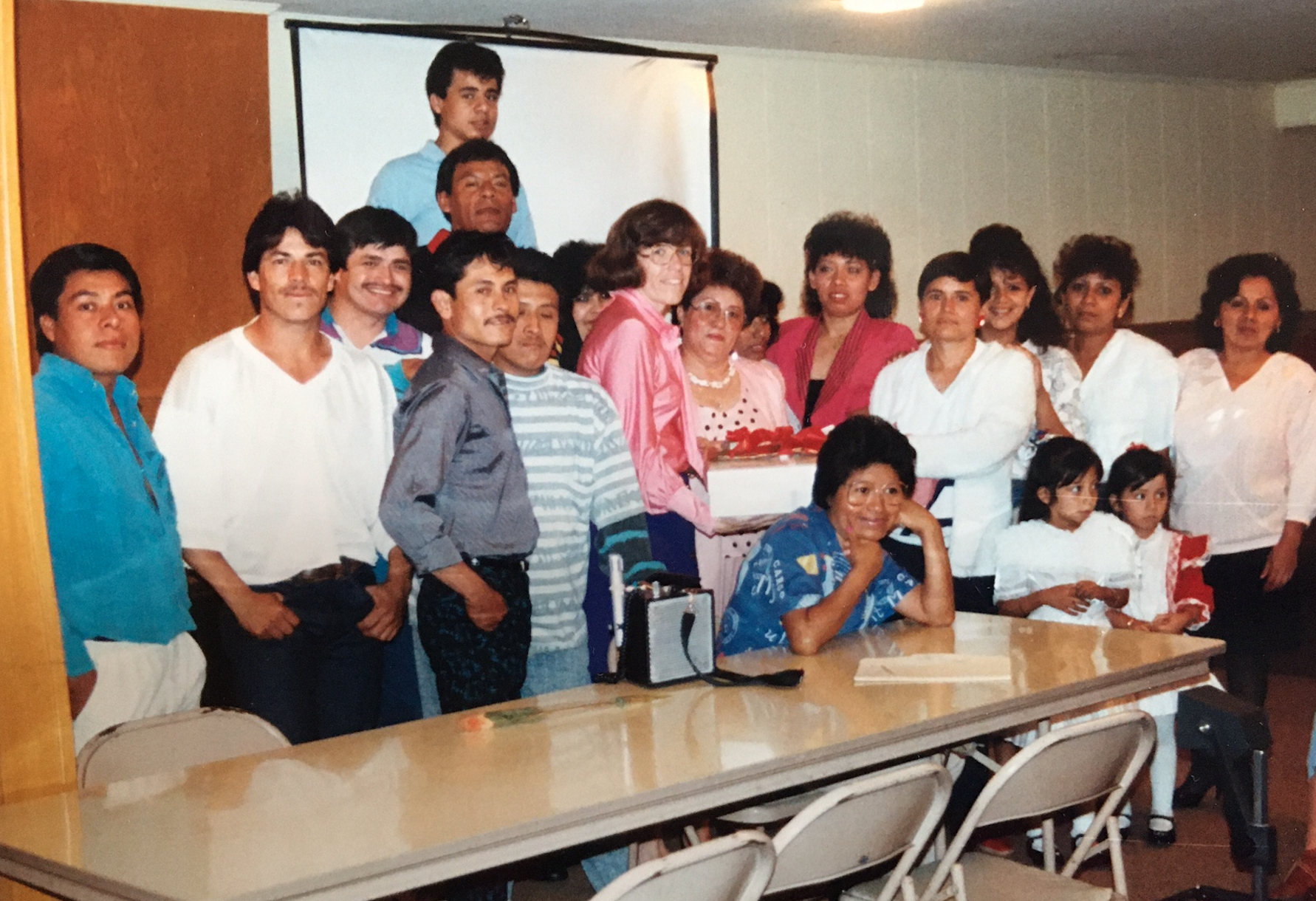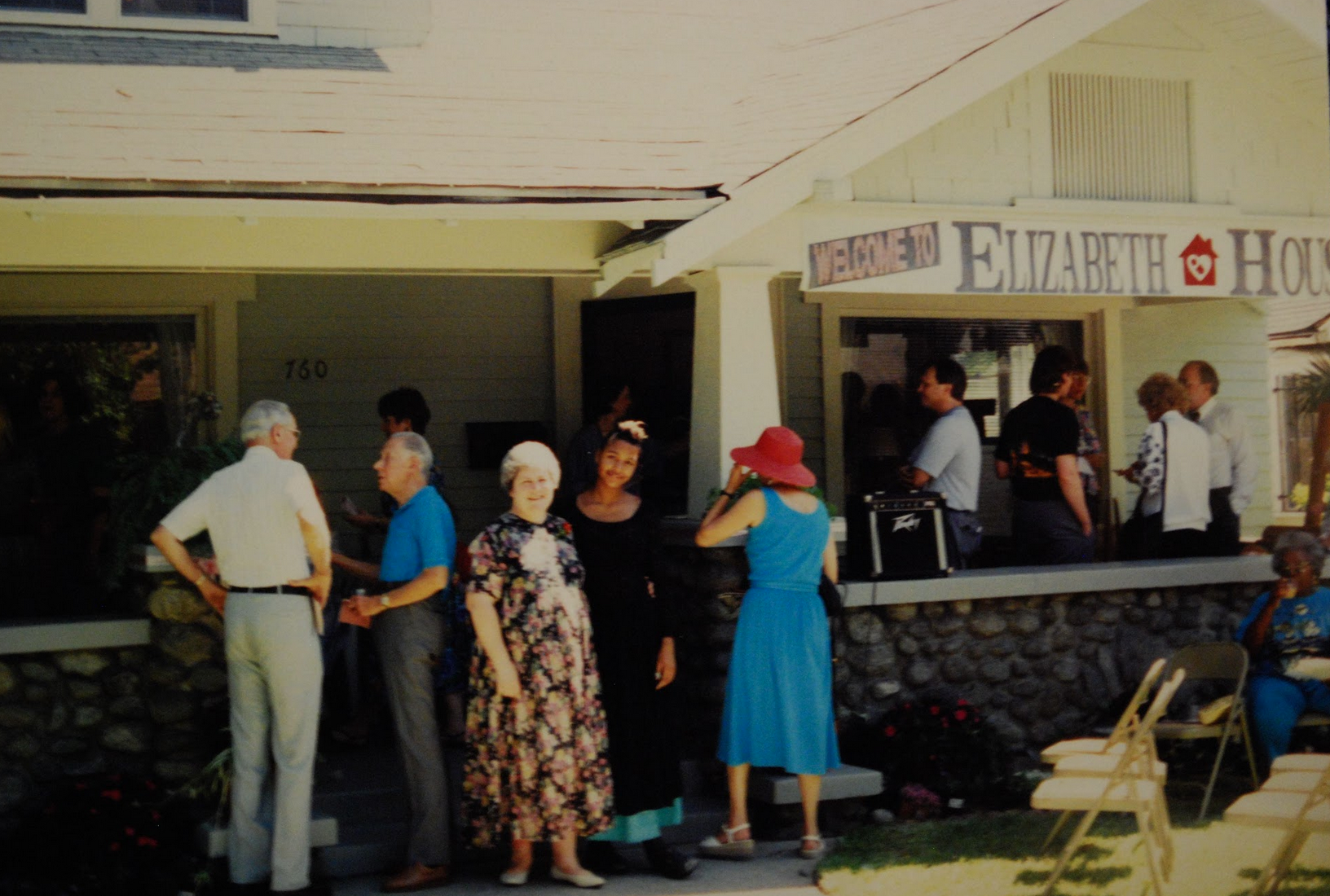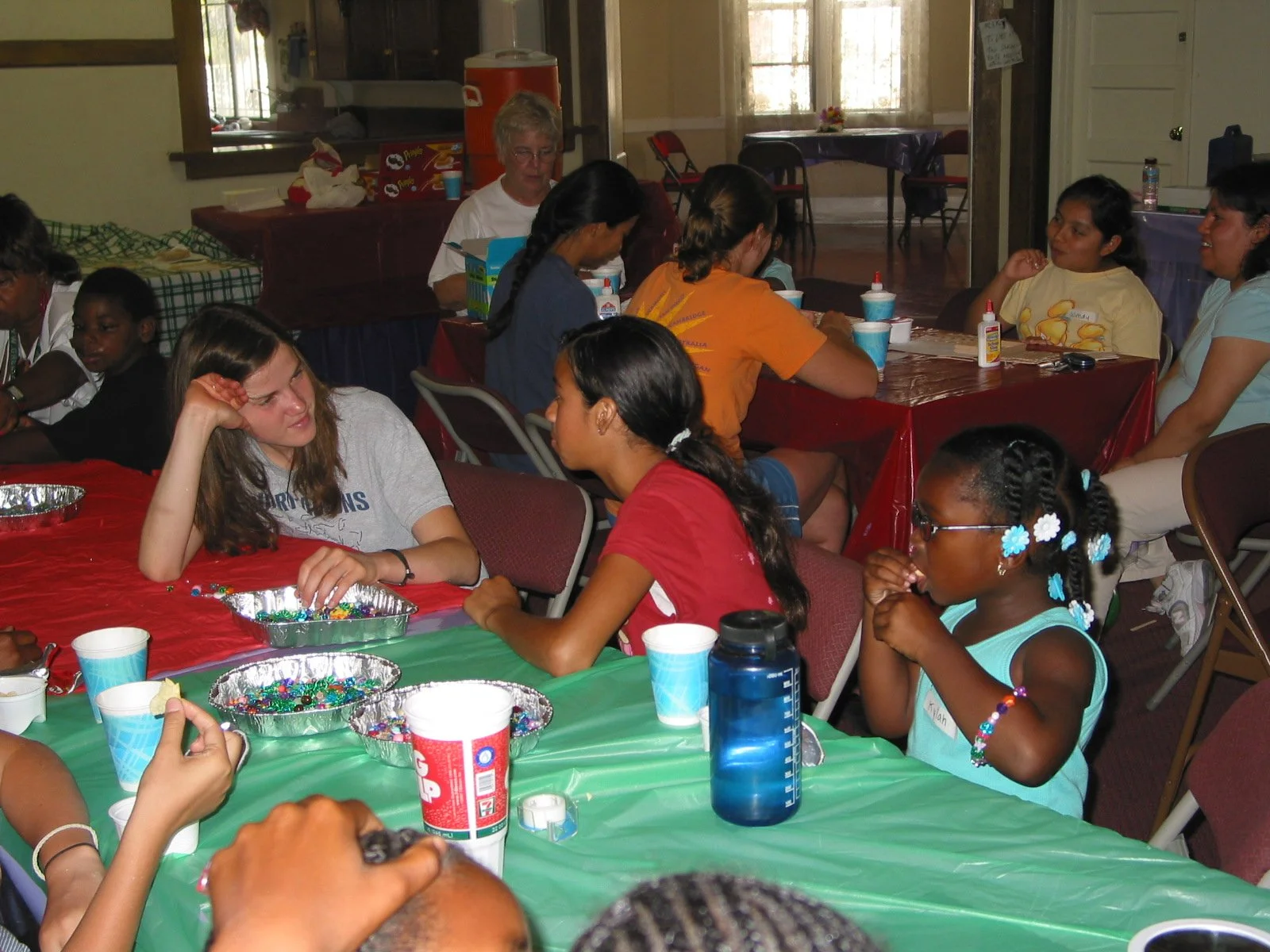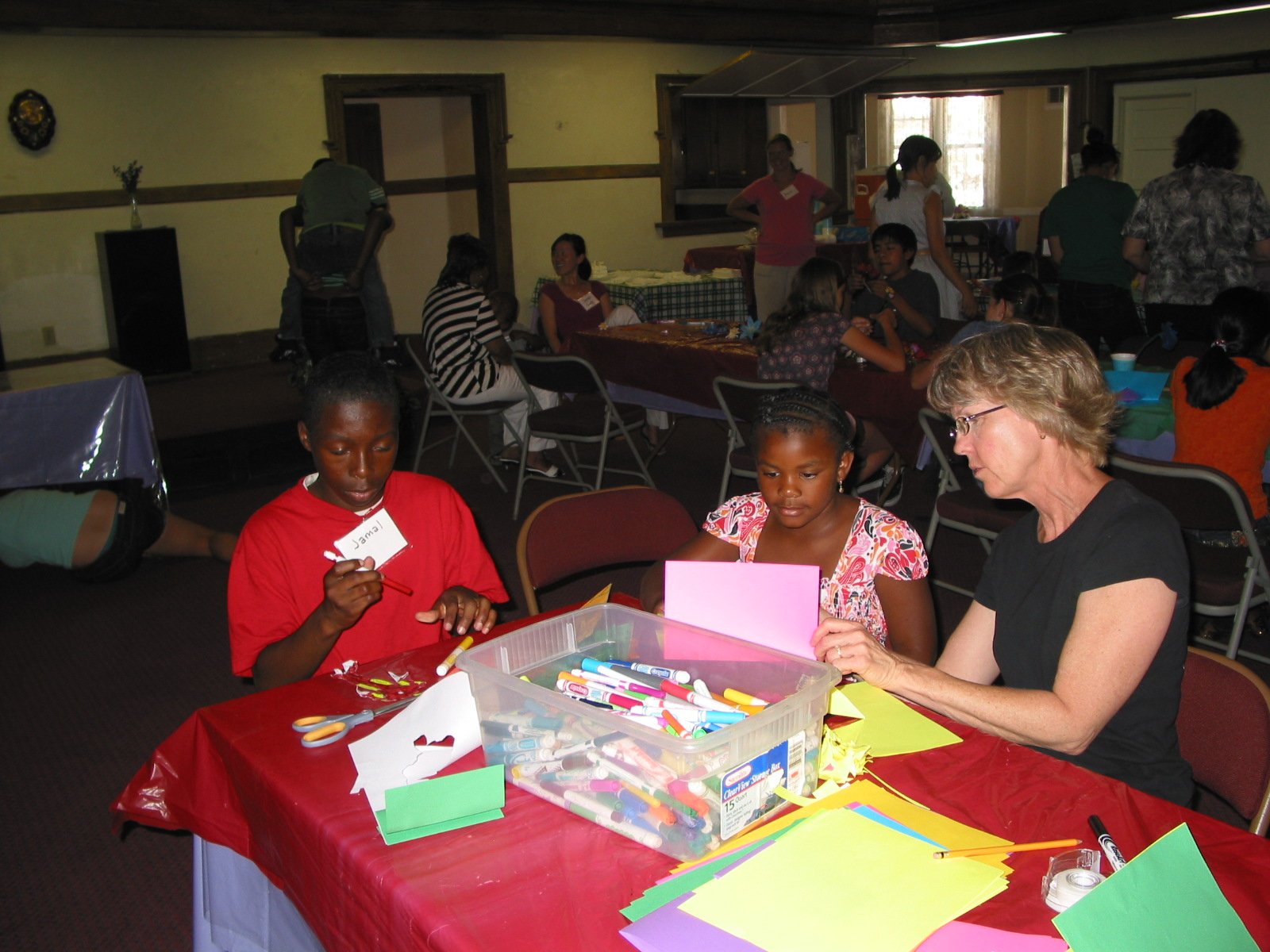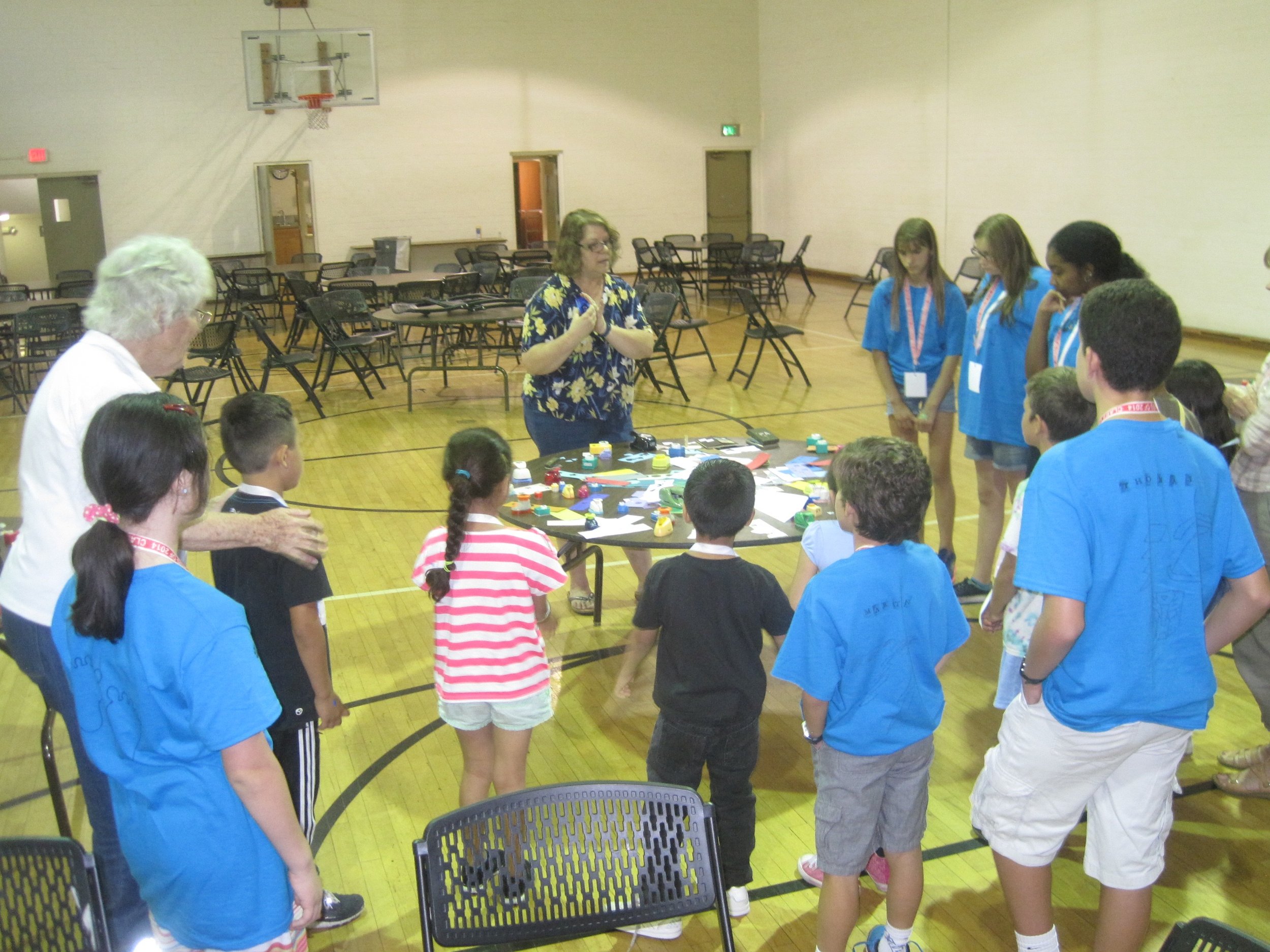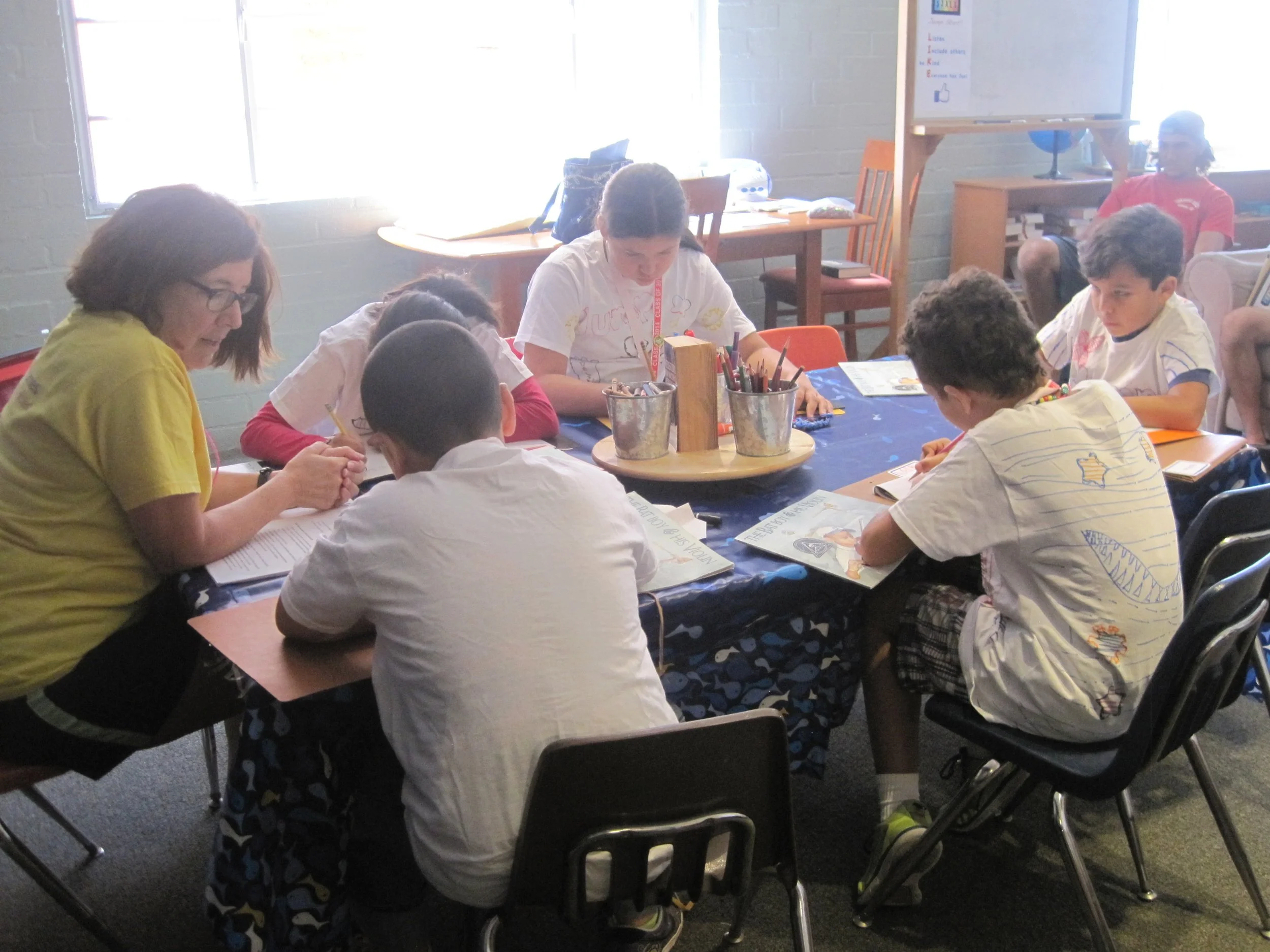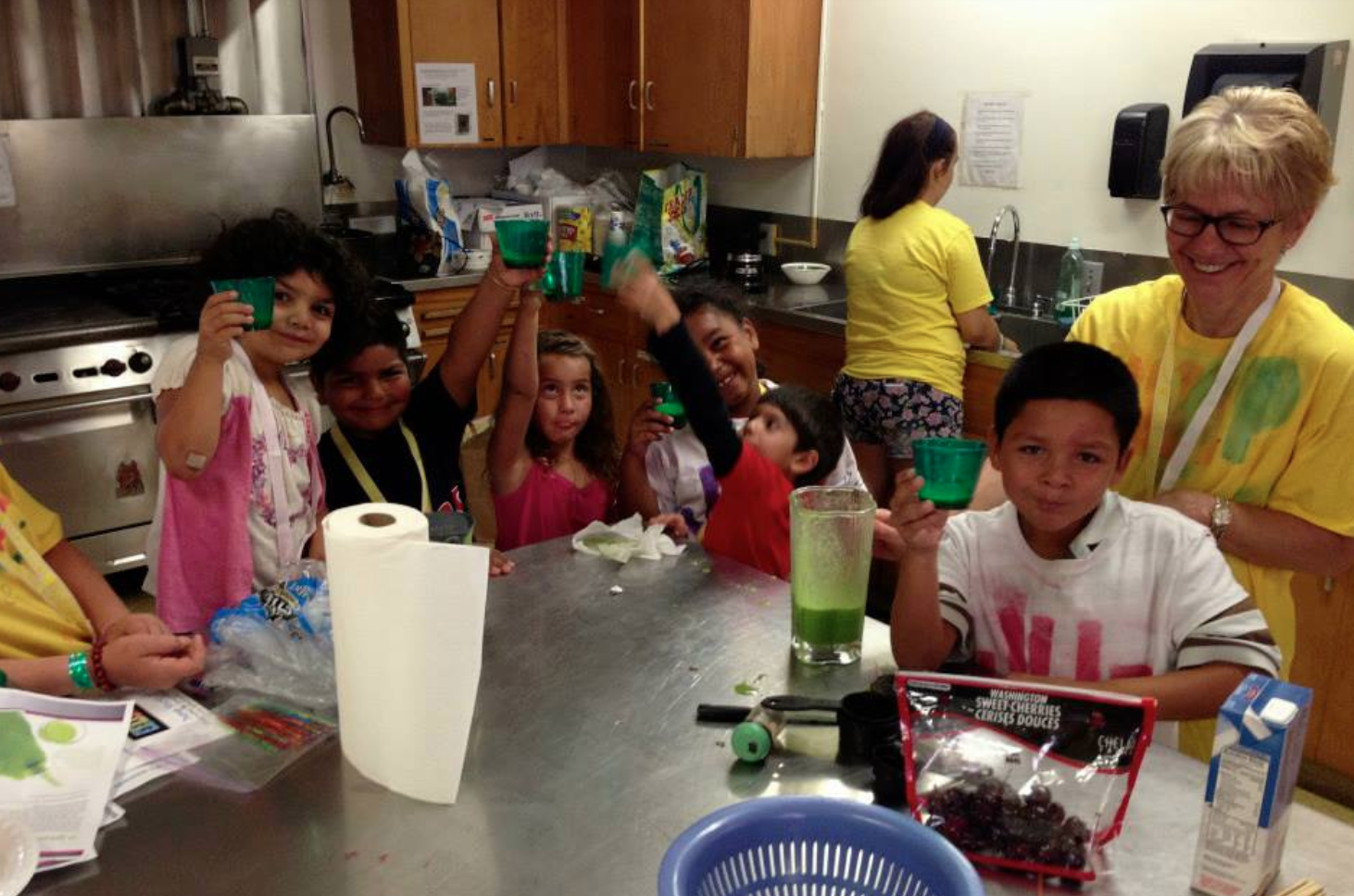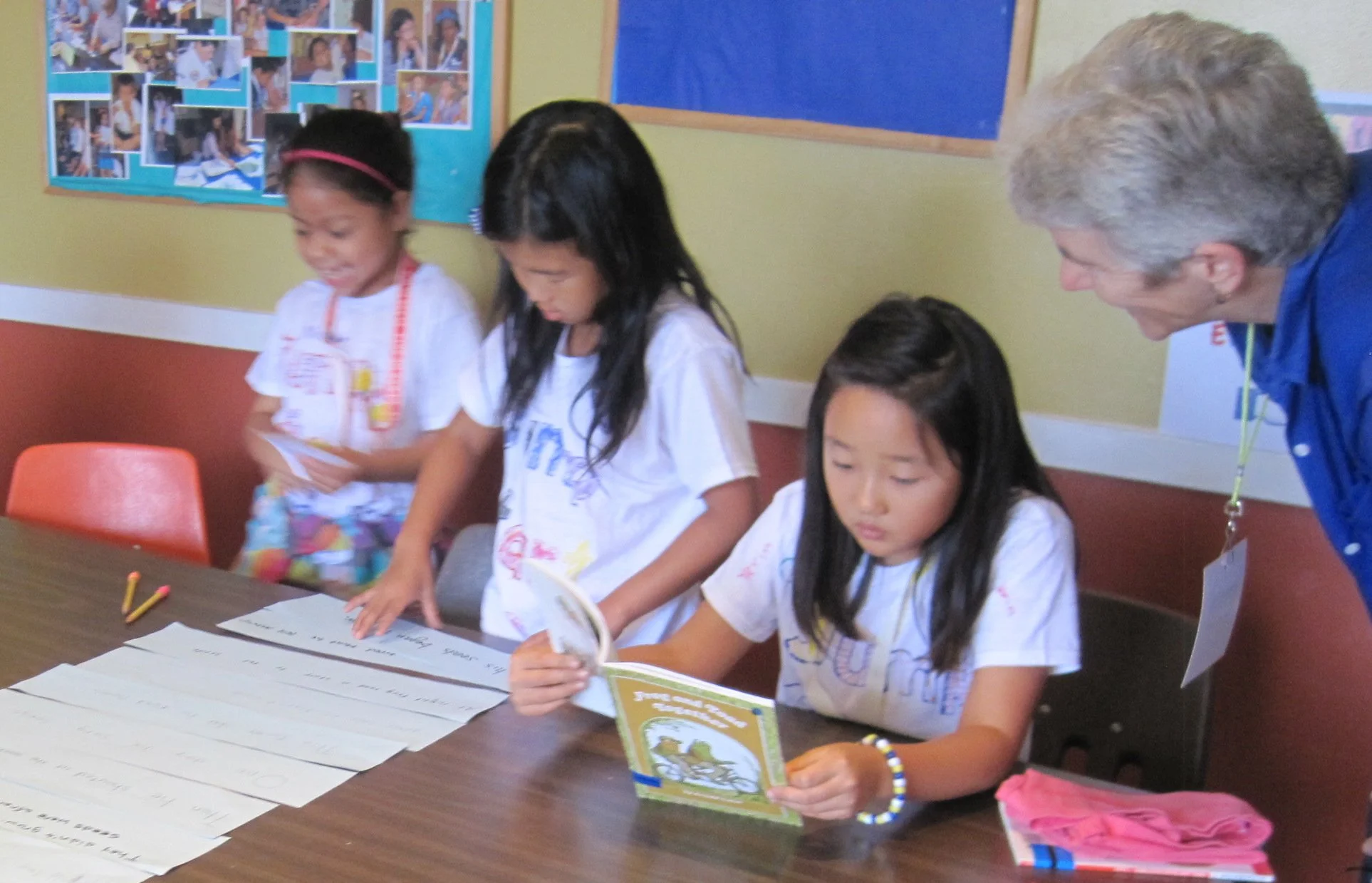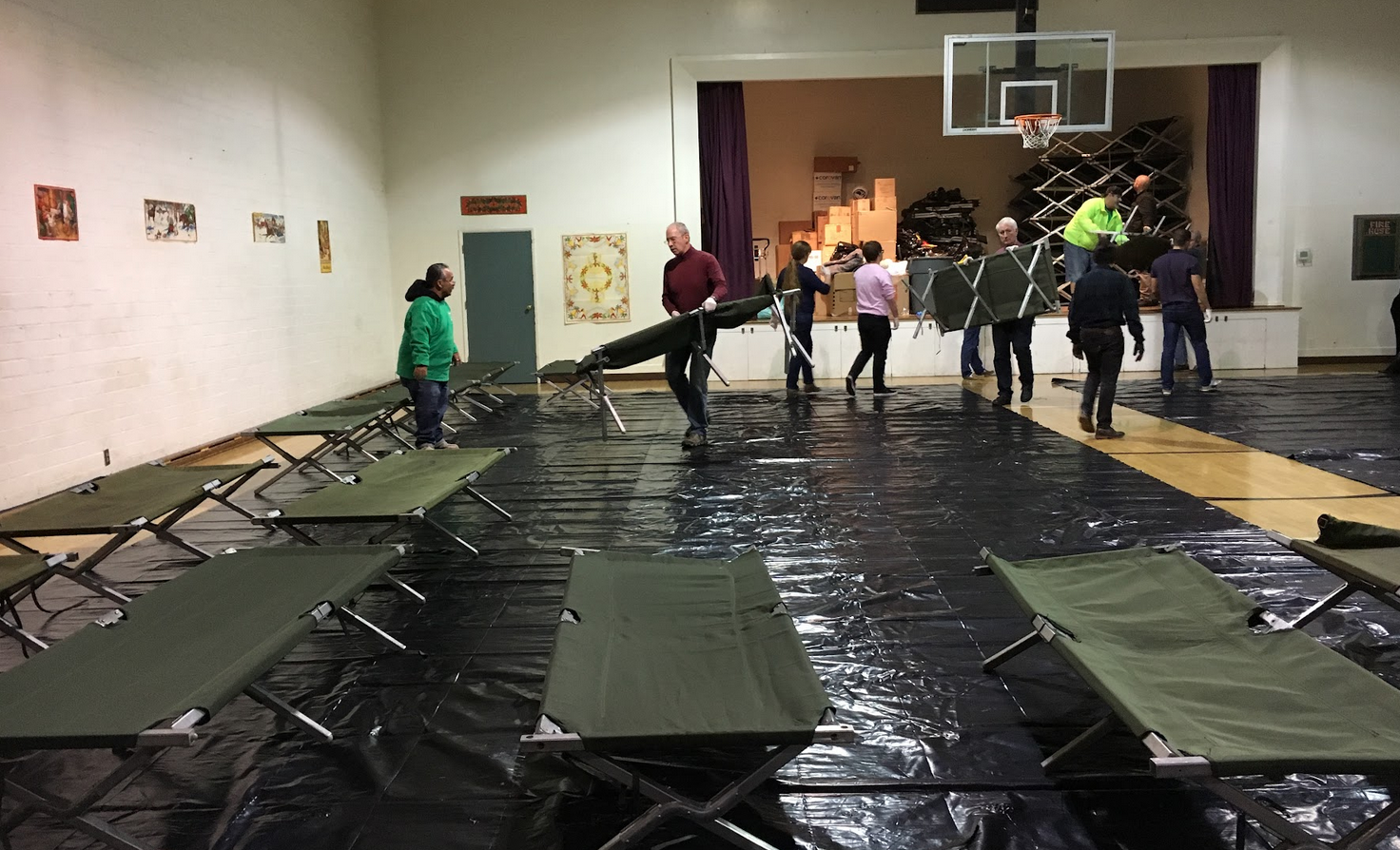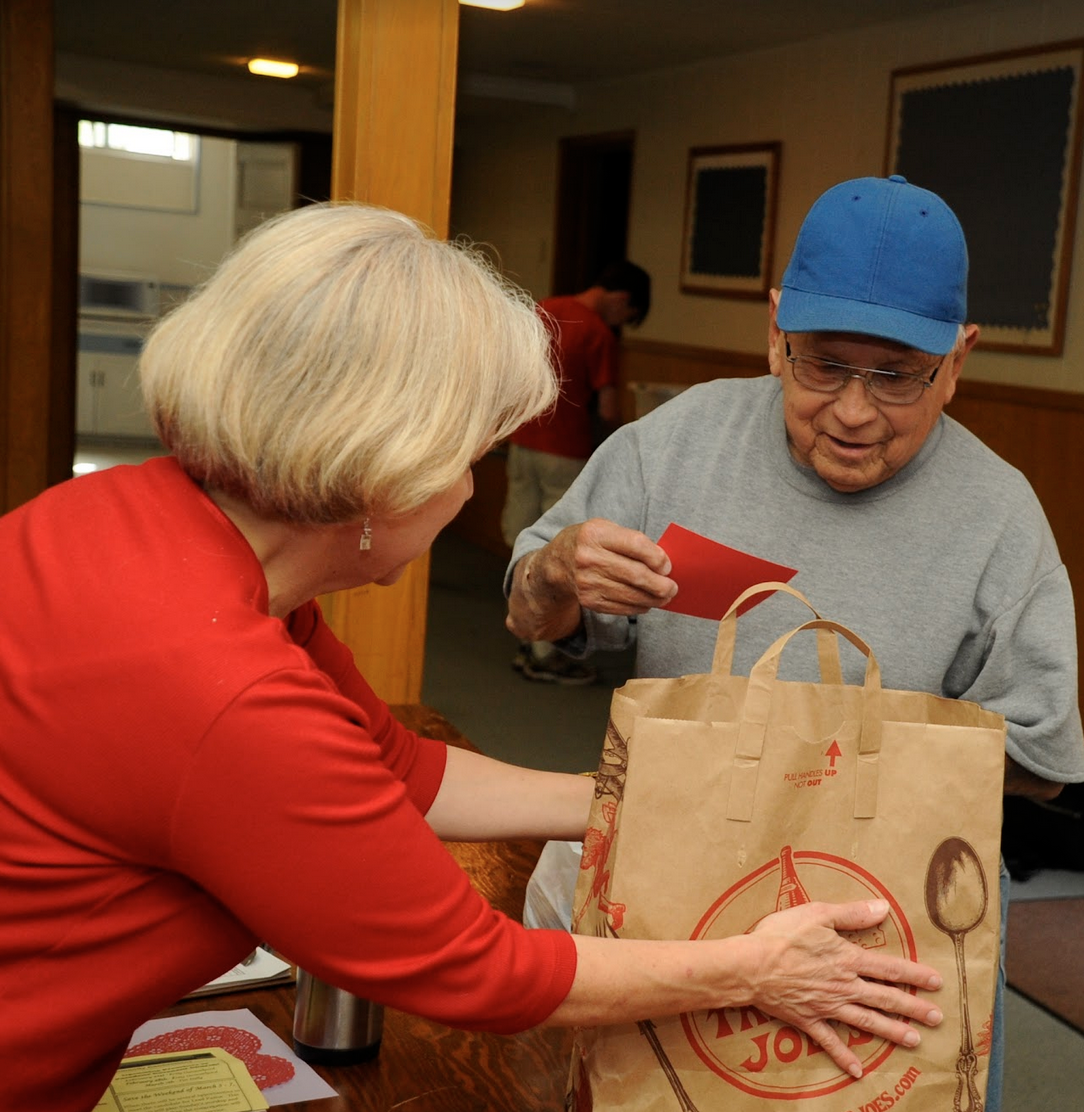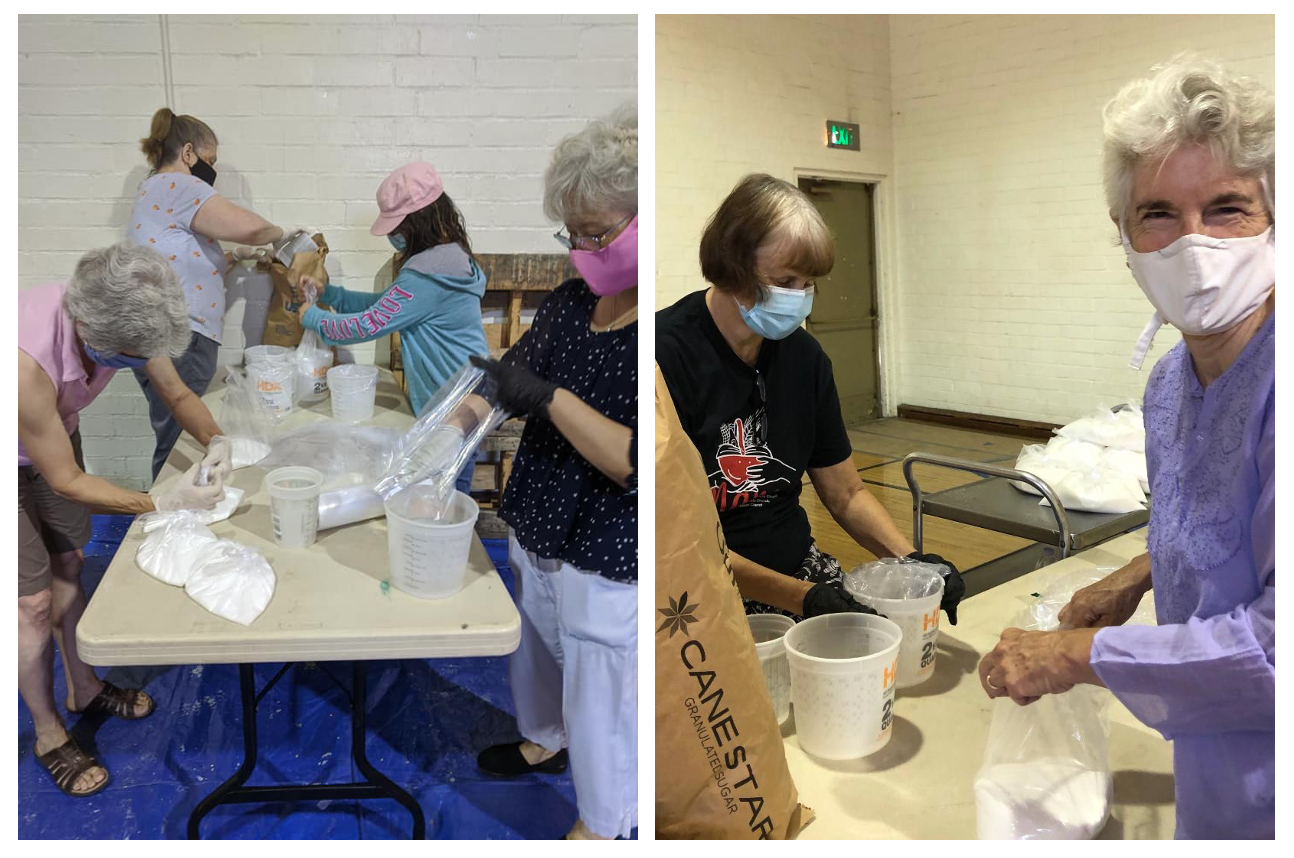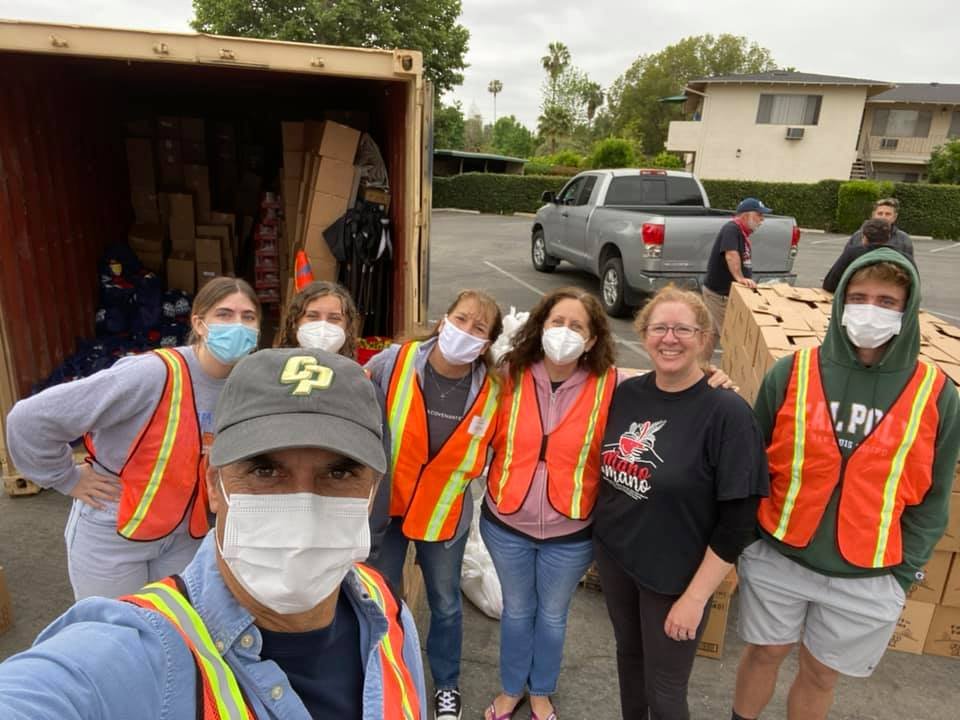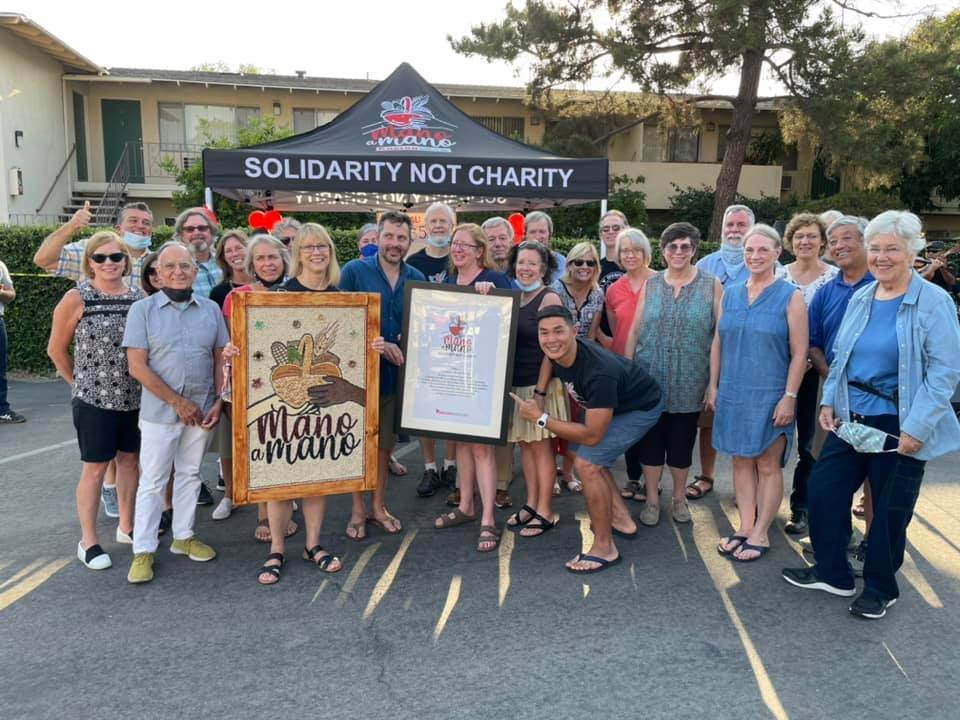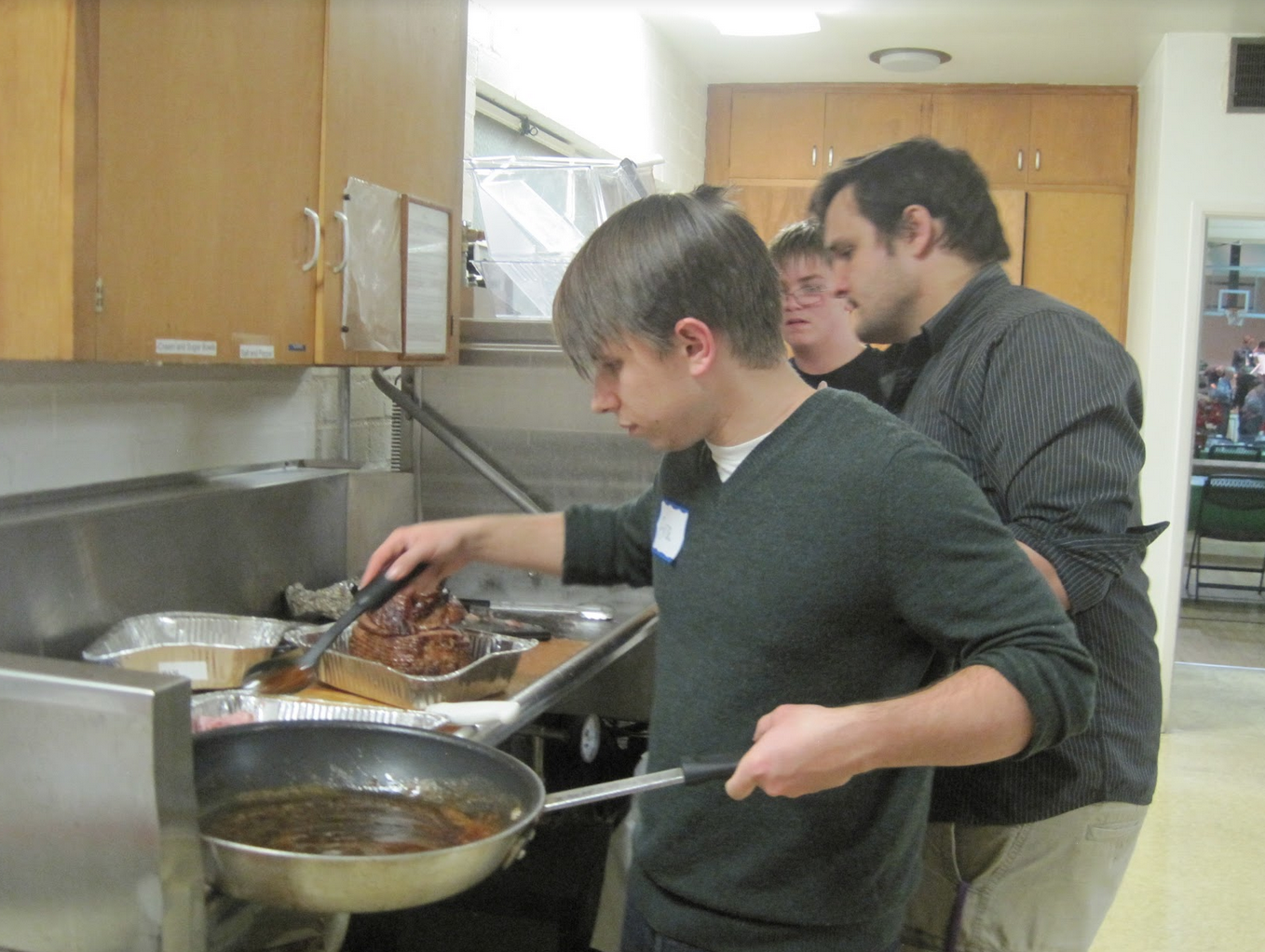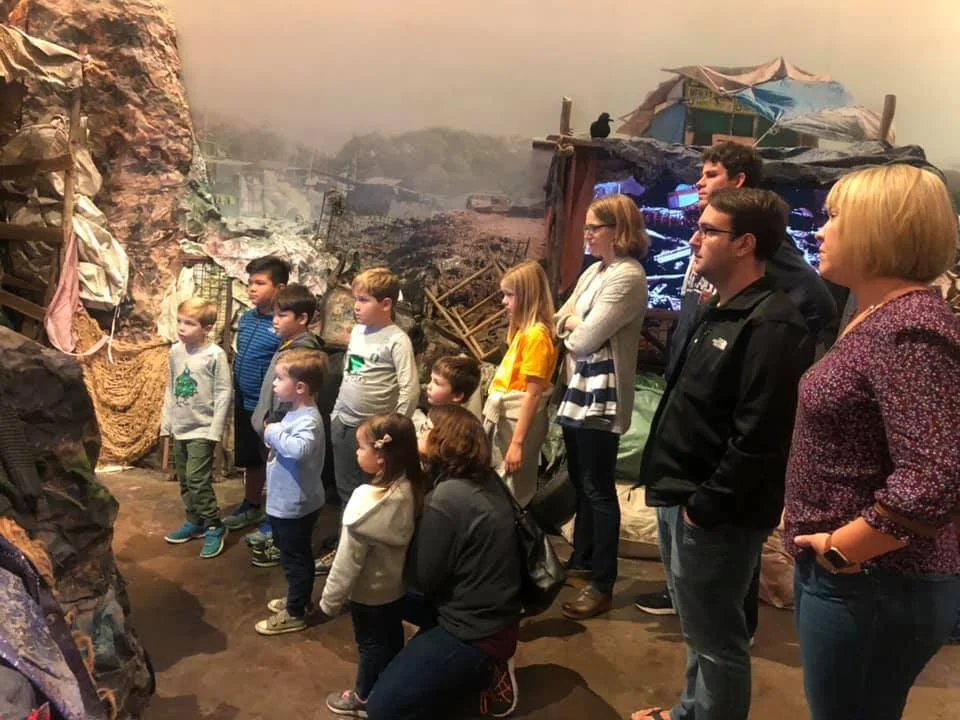Neighbors and Service
Over the last 100 years, Pasadena Covenant has helped our neighbors in many and varied ways. Specific programs have ebbed and flowed, depending on both staff and congregation as well as community needs. All these activities grow out of our commitment to obey the command in Scripture to “love your neighbor.” We believe service is a way to embody the presence of Jesus Christ and is interwoven with our proclamation of good news.
1. Earliest Days
Even before the first pastor of our church was called, there was a group focused on service. The founding women formed a Ladies Aid Society in 1919, later called the Phoebe Society, that blossomed into the church. They raised money for the needy, visited the homebound, and engaged in sewing for local and foreign groups. This commitment to helping people in the community was one of the reasons the church switched from Swedish to English. With such a beginning, it is no wonder that serving our neighbors has been important to the church in all the decades since. This post will focus on the last 50 years.
Covenant Women rolling bandages, ~ 1950s
2. The 1960s and 1970s
As Pasadena began to change from a wealthy Los Angeles bedroom community to a unique city with new freeways, a convention center, hotels, and high-rise business buildings, urban problems also emerged: poverty, joblessness, hunger, and addiction. Operation Help was an “expanded ministry of benevolence and evangelism” begun in 1969 to meet these new needs. It offered rides; housing assistance; references for legal advice, jobs, or counseling; food; clothing; and prayer. A canvas of the neighborhood was conducted to acquaint the community with Operation Help and find out more about local needs. Services became more accessible to the community in October 1970 when the church decided to use a Lake Avenue-facing house on its property for the program (where the former “youth building” is). Three young men who were Campus Club counselors (David Hicks, Curt Peterson, and Dennis Dawson) rented the second floor of the house, providing income for the program (along with donations from the church’s high school and college groups). The first floor of the house held a clothing and food commissary and receptionists who fielded calls to the program’s number, 449-HELP. When a stalwart volunteer, Edith (Mrs. Knute) Johnson, died in 1975, however, the program proved difficult to maintain.
Another issue at the time was race. The path of the 210 freeway built in the 1950s and 1960s unequally affected African Americans. Furthermore, in 1970, the Pasadena School Board was under a court order to desegregate schools and a program of forced bussing was instituted. White families with means moved to other nearby cities or sent their kids to a growing number of private schools.
The church’s response to these changes was in part expressed through the work and interests of individual members. One of these was Albert Lowe, church member and advocate for public schools. He was on the Pasadena school board at the time and tried to build bridges between the interests of white and black parents.
Another was Roy Bicker, active in Pas Cov since he was a teenager, and a public elementary school teacher. He was a friend of Ed Bryant, a prominent African American in NW Pasadena. Ed’s job was court liaison between juvenile defendants and the prosecutor, but his heart was in the Pasadena Youth Christian Center, which he had founded in 1965, to stop those juveniles from getting into the court system in the first place. Roy supported the PYCC as a board member, encouraged Pas Cov to put it in the budget (where it was until 1998), and arranged for church members to become tutors at the center.
Pas Cov also responded along with the larger Covenant denomination to the 1969 “Black Manifesto” call for reparations from American churches. They agreed to additional giving to “help lift the burden of indignity imposed on the black communities of America.” More on this piece of Covenant history can be found here. The first offering for this cause was taken in an evening service at Pas Cov in February 1970 in which the invited speaker was Robert Dawson, the first African American member of the Covenant’s ministerium, and pastor of Grace Covenant Church in Compton (a building which is now the home of CHET, the denomination’s Hispanic Bible institute).
3. 1980s and beyond: Community outreach
In 1979 Dave Mark was brought on staff at Pas Cov as Minister of Community Outreach. Serving until he and his family moved to Mexico in 1983, he helped the congregation understand “The Church’s Mission in a Changing Community,” the title of a talk he gave at an evening church service. Sharon Smith was on staff in a similar role from 1984 to 1989.
One of the ways this mission of the church was carried out was through a house at 760 Santa Barbara St. The details of ownership, rental, use, and acquisition are complicated—suffice to say that Pas Cov was able to use it as an outreach base starting in the mid-1980s. The house had room for five adults, and church members such as Jim Crapson, Todd & Karie Shorack, David & Lori Vriend, Edgar Castillo, Dan & Diane Moore, and others lived in the Community House until 1990, engaging in the challenges of life together and reaching out to the neighborhood.
Most of what the Community House residents did was to be good neighbors, from sharing dinner to giving rides, discussing parenting, and celebrating kids' birthdays in the front yard. But there were related ministries at the church as well. One of them was Kids Club. Volunteers gathered the kids and brought them to the church one afternoon a week for a meal, games, crafts, and Bible stories. At some point the Pioneer Club curriculum was used. More tutoring options were added as well. (Here is a more detailed account of the Community House.)
English as a Second Language (ESL) classes at the church for adults were also part of the outreach mix during the 1980s and 1990s. In 1987, there were about 80 students. After an immigration reform bill from President Reagan, demand for ESL classes spiked and Pasadena City College’s Community Skills Center used the church as a satellite site. In 1989-90 there were up to 200 students in four different classes. Local pastors such as Marcelo Alvarado came to give short devotionals during the class break. After that surge, the program was smaller and more informal, led in large part by PCC teacher and church member Ellen Herring.
There was also a focus on Spanish speakers and church. In 1984, with the help of Los Angeles Covenant, a Spanish Bible study and a fellowship evening began at the Community House. By 1988 there was a Hispanic worship service in Pas Cov’s Fireside Lounge. However, after Sharon Smith left staff in 1989, the small congregation was entrusted to others, such as Pastor Marcelo.
The role of the house at 760 Santa Barbara St. also shifted in 1990. The new vision emerging for this house was for it to be a home for women in crisis pregnancies. It took several years for the vision to become a reality, but in 1993 Pas Cov member Debbie Unruh became executive director of Elizabeth House and in 1994 the church readied the house with furnishings and prayer for its first resident. Owning the property was a condition for Elizabeth House to get some grants, so the church developed a way to sell the property to EH and then provide financial support (2005-2015). Since its founding, Elizabeth House has seen over 340 women come through its doors, has supported over 800 children, and has now expanded to a second house for women who need support but not necessarily shelter. (Here is more of Debbie Unruh’s story related to Elizabeth House.)
Another periodic ministry has been basketball in the gym. In the late 1980s, Kevin Brooks and Todd Shorack opened the gym for neighborhood players, mostly African American young men. Todd ran the program for the three years he lived in the Community House. His dad had died in combat in Vietnam, and he writes, “Many of us missed our own fathers and were trying to figure out how to be fathers ourselves. So, praying, ‘Our Father, who art in Heaven…’ each week was standard.” In the early 2000s, James McMillan and Kyle Michealsen started playing basketball with students from the church youth group and their friends. As time went on, the players were more and more students whom Kyle taught at Pasadena High School and students from the neighborhood. Kyle writes, “I felt like if a high school student never stepped foot in a church, but their experience of Pas Cov was one that welcomed them in with no questions asked, it was a win.”
Our work with Church of the Redeemer between 2003 and 2008 provided another opportunity for many Pas Cov families to be involved in community service. Our activities there have been described in the post about Families and the post about Evangelism. The following photos are from Vacation to LA 2008 and include Jamie Knauss, Mary Barkman, Jennifer Mawhorter, Emilie Still, Becky Still, and others.
Later, closer to home, our community outreach was done in partnership with Madison Elementary School. In addition to food donations, people like Dorothy Patzia, a former school librarian, were regular tutors there from 2011 to 2018.
Another recent program was Jump Start. Pastor Vikki Randall led these week-long day camps to get neighborhood kids ready for school after the summer vacation in August from 2013 to 2018, supported by many church volunteers.
4. Bad Weather Shelter
A very significant commitment to our neighbors was our hosting of the Bad Weather Shelter in the gym from 1989 to 2019. This program was overseen by the organization Ecumenical Council/Friends In Deed to offer shelter to homeless individuals, at first during the entire winter and in later years when the weather forecast was for rain or cold. At its peak, over the course of a typical winter season, the church opened its doors 77 days and hosted upwards to 4,370 people. Nurse clinics, foot washing, gift bags, and special meals were included at some points. Key lay people overseeing this ministry were Don Bosch and then Wayne Walker, though many volunteers were involved on Wednesday nights when Pas Cov people joined Friends In Deed staff as hosts. Climate change and drier weather, new city and non-profit services, as well as changing attitudes in the city about how to help the unhoused, were factors that led to the end of our involvement in hosting the BWS, but the impact during those 30 years was great both on those who were served and those who served. Hundreds of Pas Cov people gave money, time, and attention to ensure the security and health of thousands of people experiencing homelessness over the years, putting into practice the service Jesus asks for in Matthew 25.
5. Refugees
In 1980, the church helped sponsor a refugee family from Vietnam, the Trans. In 2018 the Peace and Justice ministry team was again led to focus on refugees. Pas Cov helped a family from Honduras seeking asylum here move from a converted garage to a real apartment; they also gathered household goods to donate to other families through the organization Catholic Charities where Pas Cov member Brenda Thomas works. When the flow of refugees slowed, attention shifted to visiting detainees at the ICE detention facility in Adelanto. Dozens of volunteers drove out to the facility over several months and listened to detainees’ stories. In July 2019 some also gathered at a candlelight vigil to protest inhumane conditions there. The pandemic ended this ministry to these marginalized and vulnerable people.
Melissa Heuer & Viann Duncan at Adelanto vigil, 2019
6. Food
Food was distributed via Operation Help in the 1960s and 1970s. In the late 1980s, food again became one of the ways we served the community. At first, there was a “food closet” in the church, with donations solicited from both the congregation and local grocery stores. In 2011 the service was moved to the Madison Family Center at Madison Elementary School (until 2018). Among the many who dedicated hours to the Food Closet, Lois & Bob Bascom deserve recognition.
In March 2020, during the pandemic stay-at-home order, the Pasadena Community Job Center, located across from the church, approached Pastor Steve Wong about emergency food distribution. They were concerned about day laborers in Pasadena who had found themselves suddenly out of work, and their families, especially those who were undocumented and didn’t qualify for any government benefits. The Center could get donations from the Los Angeles Food Bank, but there were space requirements, and they wondered if the church could help. As a relatively new pastor here, Steve had been praying about local ministry outreach and received their inquiry as an answer to prayer. Mano a Mano (“hand to hand”), launched in April 2020, and delivered food to about 240 households in the Pasadena area with the help of 40 volunteers. As the pandemic waned, Mano a Mano has evolved. At the beginning volunteers packed bags of beans, rice, and other staples in the church gym; now the work is done in the Job Center. Drivers still deliver to about 35 elderly or disabled recipients, but others pick up food themselves. More workers come from the ranks of the Job Center now, but Pas Cov still provides regular volunteers coordinated by Marianne Haver Hill. (Here are more details about our involvement with Mano a Mano.)
7. The next generation
Pas Cov is committed to raising young people to serve, so projects like Church of the Redeemer and the Bad Weather Shelter incorporated our youth (more photos here). Other youth- or family-focused activities that helped the church learn about and empathize with others have included World Vision’s 30-Hour Famine and Poverty Encounter by Children’s Hunger Fund.
Conclusion
The specific services and ministries our church has been involved in have varied over the years. We have hosted I-CAN, a mental health program; CAN-DO Kids, an after-school program for the neighborhood; and a shower program for homeless men. Union Station, Door of Hope, Habitat for Humanity, WorkNet, Harambee Ministries, and Northwest Neighbors have been other programs we have supported directly or indirectly. Organizations have opened and closed, volunteers have come and gone, and interest in particular areas has waxed and waned—but the church has consistently been committed to serving its neighbors. We are grateful to everyone–serving both as leaders and behind-the-scenes helpers–who have kept the priority of loving mercy and doing justice central for our church.
Beyond 100
Who will our neighbors be in the coming decades? What will they need? How can we serve them in the name of Jesus?
P.S.
John Stott writes: “We have two instructions of Jesus – a great commandment, “love your neighbor,” and a great commission, “go and make disciples.” What is the relation between the two? Read the entire article here.
We are so grateful to the many who have sought to follow God over the past century,
and now we seek to imitate their faith for the next hundred years.
Please join us in giving to this legacy of faithfulness!

